Working at any sort of height can be extremely dangerous and if great care is not taken then it can results in serious if not fatal injury! In 2023, 40 employees lost their lives by falling from a height, an increase of 11 on teh year before.
Thankfully, on the whole, this number has decreased since teh introduction of The Work at Height Regulations in 2005.
In this project we concentrate on the use of tower scaffolds which can be used to gain access pretty much everywhere and are accessible to DIY enthusiasts.
What is Scaffolding?
Scaffolding is a temporary structure employed in the construction industry to provide a secure elevated platform for workers and materials to enable the safe working at heights for a range of building, maintenance and repair projects.
Constructed of sturdy materials such as steel or aluminium, its modular design enables it to adapted and fit almost any structure and any height, allowing workers to operate safely and securely without the risk of falling and serious injury.
Common components of a traditional scaffold system include standards, ledgers, and transoms, couplers and joiners, planks for standing and numerous guards to prevent falls and material droppage.
Although traditional scaffolding systems are reserved fo use mainly by tradesmen, and can only be legally erected by those that are qualified to do so, if there is no need for a full-blown setup or it’s a smaller DIY job, then a scaffold tower can be used. More on this below.
Whether employed for construction, painting, or maintenance endeavors, scaffolding is a versatile solution that ensures both worker safety and project success. Its prevalence in the construction industry underscores its indispensability, offering a reliable means to reach heights and navigate complex structures with precision and full safety.
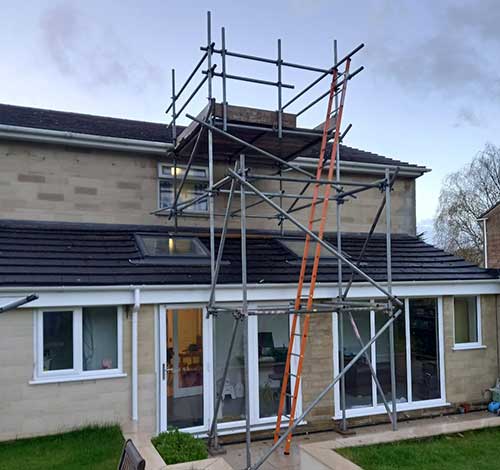
Standard scaffolding as used by many construction trades
What is a Scaffold Tower?
A scaffold tower stands is a versatile and portable elevated platform, designed to facilitate a range of construction, maintenance, or repair tasks. Constructed of sturdy materials such as aluminum or steel, scaffold towers offer a secure and temporary structure that grants workers access to elevated areas with enhanced safety and efficiency.
Unlike traditional scaffolding, a scaffold tower is characterized by its freestanding nature, providing a self-supporting structure that doesn’t rely on the building it surrounds. This autonomy makes scaffold towers particularly adaptable to various projects, allowing for easy movement and repositioning as and when needed.
Due to its modular makeup, it can be easily erected by those without the necessary skills or qualifications needed to construct a full scaffold system, such as DIY’ers.
The key components of a scaffold tower include modular frames, platforms or walk-boards, guardrails, braces, casters (wheels) or feet work and various other parts all work in unison to create a stable and secure working environment. Scaffold towers come in different configurations, such as single-width or double-width and a particular solution will depend on the job at hand.
In the majority of cases, scaffold towers can be erected by one individual but we always suggest that two people (with, sometimes, a third person) are involved for safety reasons.
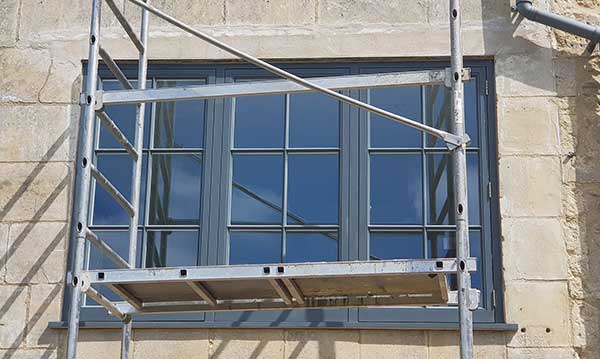
Standard scaffold tower
As scaffold towers are the more accessible item for DIY’ers and homeowners, we will focus more on this means of access rather than the full blown scaffold system, as this is limited to only those that are qualified to efect them.
The Do’s and Don’ts of Using Scaffold Towers
Due to teh potential safety risks of using a scaffold tower and working at height, there are several do’s and don’ts when it comes to erecting and using them correctly. The most important of these are:
- The tower is level and on firm ground. Make sure the castor wheels are locked and the tower cannot move or wobble
- Many towers have out riggers; don’t take a risky short cut and not use these, they are a must to prevent the tower toppling over. Follow the instructions for constructing your tower carefully
- Never exceed the manufacturers limits, particularly in height
- Don’t use them in strong winds, or if parts are missing or even broken – the strength of the tower comes from all the parts and if one or some are missing it could weaken your tower dramatically
- Reduce the height of the tower to no more than 4 metres and remove all equipment (and people!) from the tower before moving it. Check for potholes and uneven ground before moving and always pull or push from teh base only
- Check for cables and overhead obstructions when moving
Do you Have to be Trained to use a Scaffold Tower?
The question of whether training is required for using a scaffold tower hinges on various factors, primarily the context of its usage.
If you are an employee using a scaffold tower as part of your job, your employer is legally obligated to provide proper training. This encompasses instruction on erecting, accessing, and moving the tower, along with adherence to safety measures like PPE, guard rails, and considerations for working in busy areas. These regulations are outlined in the Work at Height Regulations 2005 and are applicable to all employees and companies.
Conversely, if you’re a member of the public intending to use a scaffold tower for DIY purposes without employer instruction, there is no strict legal requirement for training. However, it is strongly discouraged. Many hire companies typically offer basic training on proper tower assembly and safe usage. When hiring, insurance is usually included, but it can be costly. Consider obtaining your own insurance before hiring, and ensure you have proof for the hire company.
It’s crucial to note that these guidelines specifically pertain to scaffold towers. Full-blown scaffold systems have a distinct set of rules, and proper qualifications, often in the form of a “card” are mandatory for any activities involving them.
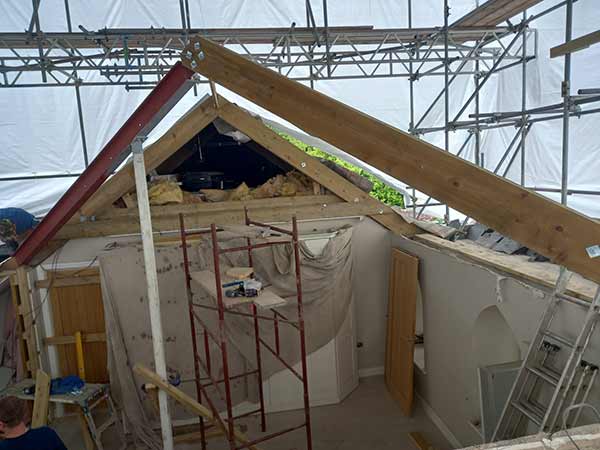
Large total enclosure scaffold and scaffold tower
Scaffolding Erection in the UK: Licensing and Safety Measures
When it comes to erecting scaffolding in the UK, the question of needing a license is crucial. Erecting a standard tube scaffold for a DIY project is absolutely prohibited for several reasons. Scaffolding is not just a trade; it is a highly hazardous one. Incorrectly assembled scaffolding poses severe risks, and the consequences can be fatal. Falls from height accounted for 40 fatal workplace accidents last year, along with numerous injuries, emphasising the critical need for proper safety measures.
According to the Work at Height Regulations 2005, individuals involved in scaffolding erection must undergo appropriate training to ensure safe usage and eliminate potential risks to themselves and others.
The Health and Safety Executive (HSE) specifies that any scaffolding crew should include at least one member with the necessary knowledge and training to erect, dismantle, or alter the scaffold for the specific job. Trainee employees are allowed to work only under the direct supervision of a fully trained and qualified individual.
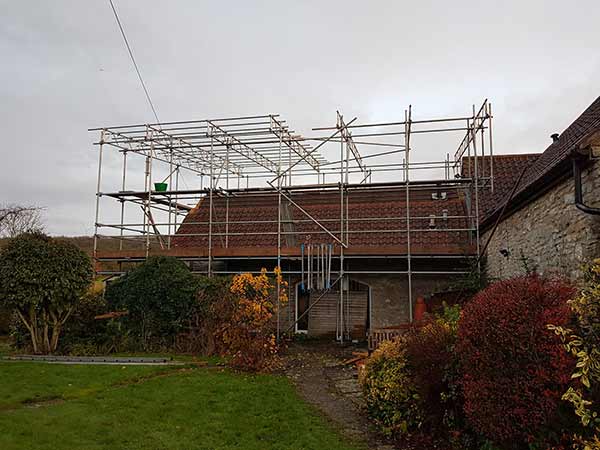
Erecting a full enclosure scaffold
Guidelines for Purchasing a Scaffold Tower
When it comes to acquiring a scaffold tower, numerous companies across the country offer options for hiring and buying scaffolding, tower access platforms, aluminium towers, podium steps, and various other access equipment. You can easily find information on these companies through online searches.
For some projects, it might be more cost-effective to purchase a sufficient sized scaffold tower and then resell it once the project is complete, especially if it’s needed for an extended period, like a self-build project.
When considering a purchase, it’s crucial that the units comply with the European Standard, BS1139 (part 3) 1994 Scaffold Standard, and HD 1004, and are fully warranted.
Scaffold towers are available in various sizes, with taller towers generally being more expensive. Standard towers typically range from 3 to 7 meters and can be assembled in different configurations, as specified in the manufacturer’s instructions.
Here are the key pros and cons of buying a scaffold tower:
Pros of Buying a Scaffold Tower
- If needed for an extended period, it can be more cost-effective than hiring.
- More affordable and easier to work with than traditional scaffolding, which requires professional adaptation.
- No waiting for availability; you can start your project immediately.
- Easy to move and adapt compared to traditional scaffold systems.
- You can customise the setup to fit your specific needs.
- Potential VAT reclamation depending on your job.
Cons of Buying a Scaffold Tower
- Can be expensive if only needed for a short time; hiring might be more economical.
- Generally cheaper to hire if budgets are limited.
- Requires storage space, especially for larger sizes.
- Responsibility for repair and maintenance falls on you.
- Full insurance coverage is necessary for usage.
- Regular cleaning is your responsibility.
- Replacement of damaged items is your obligation.
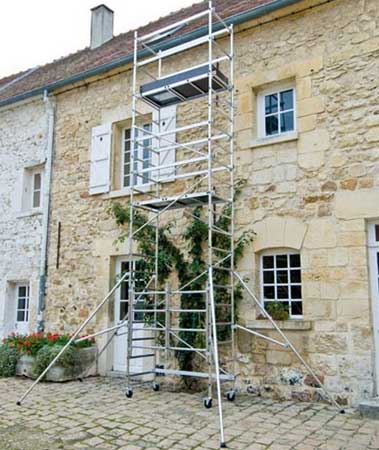
A Zarges 7 meter Tower in use
Tips for Hiring Scaffold Towers
When embarking on a project that requires scaffold towers, whether for DIY tasks or professional construction, effective hiring is crucial for safety and efficiency. Follow these tips to ensure a smooth and successful scaffold tower rental:
- Assess your needs: Understand what you’re doing. Consider the height, configuration, and duration for which you’ll need the tower
- Research Reliable Companies: Explore reputable scaffold tower rental companies
- Check Safety Standards: Verify that the scaffold towers meet safety standards and regulations
- Enquire About Training: If you or your team are not experienced with scaffold towers, inquire about training options provided by the rental company
- Understand Rental Terms: Thoroughly read and understand the rental terms and conditions concerning hire duration,cost, delivery, collection etc.
- Inspect the Equipment: Prior to accepting the scaffold tower, conduct a thorough inspection for any signs of damage
- Consider Insurance: Check if the rental includes insurance coverage. If not, take some out
- Plan for Delivery and Pickup: Coordinate delivery and pickup logistics with the rental company
- Follow Safety Guidelines: Adhere to safety guidelines and instructions provided by the rental company
- Return Equipment Promptly: Return the scaffold tower on time to avoid additional charges
When it comes to costs
| Working Height | Platform Height | Cost per Week |
| 4.2m | 2.2m | £65.96 |
| 4.7m | 2.8m | £72.39 |
| 5.2m | 3.2m | £78.82 |
| 5.7m | 3.7m | £85.25 |
| 6.2m | 4.2m | £91.67 |
| 6.7m | 4.6m | £98.11 |
| 7.2m | 5.1m | £104.53 |
| 7.7m | 5.7m | £110.96 |
| 8.2m | 6.2m | £117.39 |
| 8.7m | 6.7m | £123.82 |
The above should only be taken as a rough guide, prices will vary dependant on where you are in teh UK.
A 5.1m high platform tower is usually the maximum height hired by DIYers as this will reach the highest domestic gutter. For a normal 2-storey house the gutter height will sit at between 5m and 5.5m so you may want to hire a slightly shorter tower to avoid bending down (or nose-bleeding as it’s called in the trade) for any length of time.
By following these tips, you can make informed decisions when hiring scaffold towers, promoting a safer and more efficient working environment for your project.
Exploring Alternatives to Scaffold Towers
For various tasks, a scaffold tower may not always be the most suitable choice. Consider these alternatives based on your project needs:
Multi-Purpose Ladders
Multi-purpose ladders provide versatility by transforming into platforms. While they may not reach the height of a scaffold tower, their adaptability allows for use as normal ladders and step ladders, making them highly versatile.
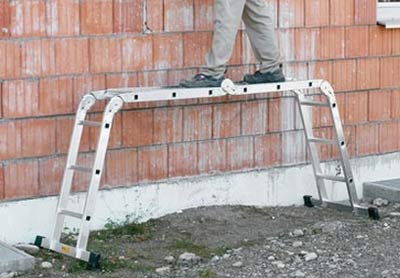
Multi-Purpose Ladder 2 x 3 and 2 x 5 Rungs
Access Platforms
An access platform, similar to a stepladder but more robust, provides a secure elevated working surface. It ensures safety when working at various heights.
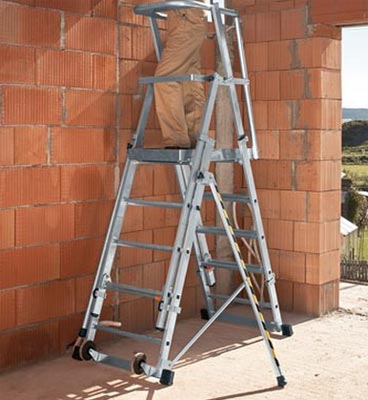
Access platform
Scaffolding
Scaffolding serves as another option, but it’s not recommended as a DIY project due to the significant risk of injury. For scaffolding projects, engaging a professional firm is strongly advised. Find trusted and reliable tradesmen in your area on our Find a Tradesman page.
Consider these alternatives based on your specific requirements and always prioritise safety.
Guidelines and Regulations for Working at Heights
Considering the inherent dangers of working at heights, it’s crucial to prioritise safety throughout every stage of using access equipment, so it’s important to look at the more detailed specifics of safety rules and legislation and provide a more detailed overview of guidelines recommended by the Health and Safety Executive for mobile scaffolds and scaffold towers.
Using the Scaffold Tower
- Avoid using a scaffold tower in strong winds.
- Never utilise it as support for ladders or any other access equipment.
- Ensure all parts are intact and belong to the specific scaffold tower type; strength is guaranteed only when all correct parts are connected.
- Erect the tower on solid, level ground with supported base plates or locked castors.
- Use outriggers or stabilisers when required.
- Do not exceed the manufacturer’s recommended height for the tower.
- Consult the instruction manual provided with the tower for correct assembly.
- Consider providing training before use.
Moving the Tower
Scaffold towers are easily transportable, consisting of lightweight sections carried directly to the work area. When moving a tower, adhere to the following safety measures:
- Reduce the tower height to 4m or less.
- Ensure no tools, materials, or people are on any part of the tower during movement.
- Clear the path of any wires, cables, overhead power lines, or telephone lines.
- Remove obstacles such as bay windows obstructing movement.
- Perform movement on solid, fairly level ground, preventing scaffold legs from digging into lawns or flower beds.
- Push or pull the tower only from the base section.
For comprehensive Health and Safety requirements related to scaffolding and scaffold towers, refer to the HSE website’s scaffolding checklist.
Additional Information Resources:
While this provides a brief overview of safety considerations, for more detailed insights, explore the following links:
- Working at Height Regulations: www.legislation.gov.uk/uksi/2005/735/contents/made
- Health and Safety Guidelines for working with Scaffold towers: www.hse.gov.uk/construction/safetytopics/scaffold.htm
Prioritise safety at all times by referring to the detailed resources above for a comprehensive understanding of regulations and guidelines.
How to Erect a Scaffold Tower: A Step-by-Step Guide
Constructing a scaffold tower requires careful planning and adherence to safety protocols. Follow this step-by-step guide to ensure a secure and effective scaffold tower erection:
Step 1 – Select the Right Tower
Choose a scaffold tower suitable for the task at hand. Consider the required height, load capacity, and any specific features needed for the job.
Also consider what additional attachments you may need, caster over base plates, stabilisers etc.
Once you know, purchase or hire the right kit and ensure it will be delivered to site in time for the job to commence.
Step 2 – Prepare the Work Area
Begin by assessing the work site. Ensure the ground is solid and level, and there are no obstacles hindering tower placement. Identify potential hazards and how you are going to resolve them.
Once reviewed, fully clear teh area of anything that could get in teh way and if the general public are within close reach, cordon off the area where teh tower will be placed. The cordon radius should be at least 1m more than teh height of teh tower.
Step 3 – Base Assembly
Firstly, designate a clear assembly area. Lay out all components, check for any damages and that you have the correct components, and ensure you have the necessary tools and equipment to get it setup.
Begin assembling the base first by connecting a castor or base plate to each side base section, ensuring castors are locked off. Either lay them down or ask a helper to hold them upright.
Step 4 – Base Frame Assembly
It’s now time to buildup the vertical frames. Holding them upright, connect the horizontal braces between each upright section, at the base of each section. Double-check the alignment and ensure all locking mechanisms are engaged for stability. They should now stay upright on their own.
Step 5 – Platform Installation
With teh main framework constructed, it’s now time to install the working platform. In most cases it should sit on second or third set of rungs, depending on teh type of platform it is, refer to teh instructions for confirmation.
The platform itself should easily hook over each rung and feature a safety catch to prevent it jumping off.
Next, attach a diagonal support at either side of teh platform, that runs from the base rung on teh side section, normally up to the third rung. Again, refer to the manufacturers instructions for confirmation.
Finally, attach any further horizontal braces to teh rungs above teh platform. These both provide extra stability to teh tower and also as side rails to prevent any falls.
Step 6 – Increase Height
With the base section assembled you can now go ahead and add any further side sections to increase teh height as needed. Simply repeat the above steps 3 – 5 to do so, making sure you have diagonal and horizontal braces inserted as suggested by teh manufacturer.
Also ensure that you feature any out-rigging or stabilisers where instructed if you are going up higher. This will prevent the tower from toppling over, so they’re very important!
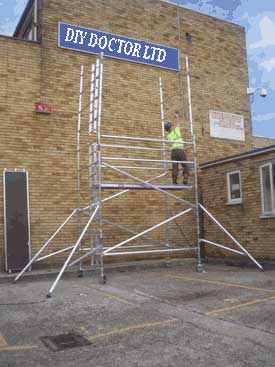
Constructing a scaffolding tower layer by layer
Step 7 – Final Checks
Perform a thorough inspection of the erected scaffold tower. Confirm all components are correctly assembled, and there are no loose or missing parts.
Also check that any and all sections of teh tower are pushed together fully where any parts slot together.
Step 8 – Tower Stability Test
Conduct a stability test to ensure the scaffold tower is secure. Apply gentle pressure to assess its stability and make any necessary adjustments.
Also, using a spirit level, check that the tower is fully levelled. If not, use teh adjusters on teh feet or castors to adjust it until it is.
Step 9 – Additional Safety Measures
Implement additional safety measures, such as toe boards and handrails, to enhance user protection. Verify that the tower complies with and any all safety regulations.
Step 10 – Access and Use
Establish safe access points and climb the scaffold tower using designated areas. This normally means climbing up internally and then on to each platform through an access hatch.
Once safely on the platform, follow best practices for the specific task at hand.
Remember, safety is paramount throughout the entire process. If in doubt, consult the scaffold tower’s instruction manual or seek professional guidance.
By following these steps meticulously, you’ll ensure a secure and stable scaffold tower ready for use in various projects.
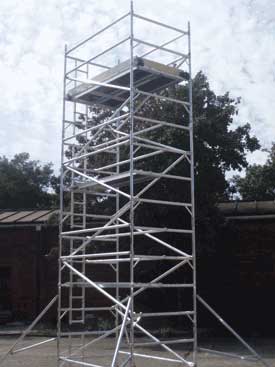
Fully assembled scaffold tower
How to Take Down a Scaffold Tower
Once you have completed the task at hand, it’s then time to take the tower down and arrange collection from teh hire company or return it to where you will store, if you own it.
The correct way to disassemble a scaffold tower is in the reverse that you put it up. Remove any toe boards on the top section and then the top platform itself, followed by bracing on teh top section and then the platform itself. Repeat this for any further sections until you are all teh back down to teh very bottom section.
Finally, dismantle the bottom section and remove any castors or feet present and then you’re pretty much done.
Scaffold towers are incredibly useful pieces of kit and provide you safe working access at a very reasonable cost when compared to more traditional scaffold systems, however it is absolutely essential that great care is taken when both putting them up and using them and that you adhere to any and all usage guidelines and you life could depend on it!

